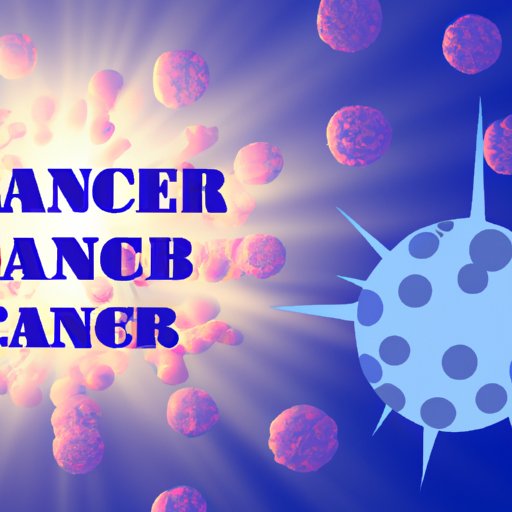Introduction
Cancer is a complex disease that affects millions of people worldwide. It is one of the leading causes of death in the United States, accounting for nearly 10% of all deaths. But what exactly is cancer? How does it work? What treatments are available?
In this article, we’ll explore the answers to these questions and more. We’ll look at the causes and types of cancer, how cancer grows and spreads, the role of genetics in cancer development, current treatments, and emerging technologies and research in cancer treatment.
Explaining the Causes and Types of Cancer
Cancer is caused by changes in the DNA of cells. These changes can be caused by environmental factors such as exposure to certain chemicals or radiation, or they can be the result of genetic mutations passed down from parent to child. This change in the DNA leads to abnormal cell growth, which can form tumors or spread throughout the body.
There are many different types of cancer, each with its own set of symptoms and treatments. The four main types are carcinomas, sarcomas, lymphomas, and leukemias. Carcinomas are the most common type of cancer, and they start in the skin or in tissues that line or cover internal organs. Sarcomas develop in the bones and soft tissues, while lymphomas and leukemias involve the immune system and blood cells.

Describing How Cancer Grows and Spreads
Cancer grows and spreads through a process called metastasis. In this process, cancer cells break away from the tumor and travel to other parts of the body, where they can form new tumors. Metastasis is a key factor in determining the severity of a cancer diagnosis, as it makes it harder to treat the cancer.
Cell division also plays an important role in cancer growth. Cancer cells divide more rapidly than normal cells, allowing tumors to grow quickly. This rapid cell division also increases the chances that the cancer will spread, as the cancer cells have more opportunities to break away from the tumor.

Examining the Role of Genetics in Cancer Development
Genetics can play an important role in cancer development. Some people are born with genetic mutations that make them more likely to develop certain types of cancer. For example, those with mutations in the BRCA1 or BRCA2 genes are at higher risk for developing breast, ovarian, and other types of cancer.
In addition to genetic mutations, family history can also be a risk factor for cancer. If multiple people in your family have had cancer, you may be at higher risk for developing it yourself.

Outlining Current Treatments for Cancer
The treatment for cancer depends on the type and stage of the cancer, as well as the patient’s overall health. Common treatments include surgery, radiation, chemotherapy, and targeted therapies. Surgery is the preferred treatment for some types of cancer, while radiation and chemotherapy are often used to treat cancer that has spread to other parts of the body.
Targeted therapies are drugs that are designed to target specific cancer cells. These drugs are often less toxic than chemotherapy, and they can be more effective against certain types of cancer. However, they can also be more expensive and may not be covered by insurance.
Examining Emerging Technologies and Research in Cancer Treatment
In recent years, there has been a surge in research into new treatments for cancer. Immunotherapy is a type of treatment that uses the body’s own immune system to fight cancer. It is being studied as a potential treatment for many types of cancer, including lung, breast, and prostate cancer.
Gene therapy is another promising area of research. In this approach, researchers modify a person’s DNA to make it more resistant to cancer. While this technology is still in the early stages of development, it could potentially offer a cure for some types of cancer.
Finally, nanotechnology is being used to develop new cancer treatments. Nanoparticles can be used to deliver drugs directly to cancer cells, making them more effective and reducing the side effects associated with traditional treatments.
Conclusion
Cancer is a complex disease that affects millions of people worldwide. In this article, we explored the causes, types, growth, and treatments of cancer, as well as emerging technologies and research in cancer treatment. While there is still much to learn about the disease, scientists are making progress in understanding how it works and developing new treatments.
If you or someone you know has been diagnosed with cancer, talk to your doctor about the best treatment options. There are many resources available to help you understand the disease and find support.
(Note: Is this article not meeting your expectations? Do you have knowledge or insights to share? Unlock new opportunities and expand your reach by joining our authors team. Click Registration to join us and share your expertise with our readers.)
